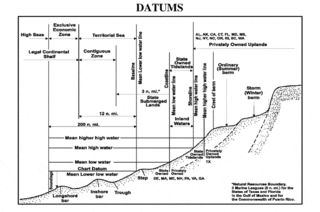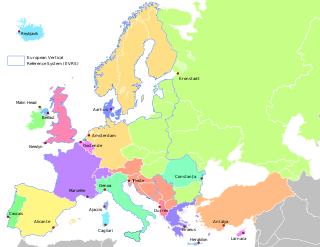
Geodesy, is the Earth science of accurately measuring and understanding Earth's geometric shape, orientation in space, and gravitational field. The field also incorporates studies of how these properties change over time and equivalent measurements for other planets. Geodynamical phenomena include crustal motion, tides, and polar motion, which can be studied by designing global and national control networks, applying space and terrestrial techniques, and relying on datums and coordinate systems.

A geographic coordinate system is a coordinate system that enables every location on Earth to be specified by a set of numbers, letters or symbols. The coordinates are often chosen such that one of the numbers represents a vertical position and two or three of the numbers represent a horizontal position; alternatively, a geographic position may be expressed in a combined three-dimensional Cartesian vector. A common choice of coordinates is latitude, longitude and elevation. To specify a location on a plane requires a map projection.

Mean sea level (MSL) is an average level of the surface of one or more of Earth's oceans from which heights such as elevation may be measured. MSL is a type of vertical datum – a standardised geodetic datum – that is used, for example, as a chart datum in cartography and marine navigation, or, in aviation, as the standard sea level at which atmospheric pressure is measured to calibrate altitude and, consequently, aircraft flight levels. A common and relatively straightforward mean sea-level standard is the midpoint between a mean low and mean high tide at a particular location.

The World Geodetic System (WGS) is a standard for use in cartography, geodesy, and satellite navigation including GPS. This standard includes the definition of the coordinate system's fundamental and derived constants, the ellipsoidal (normal) Earth Gravitational Model (EGM), a description of the associated World Magnetic Model (WMM), and a current list of local datum transformations.

A geodetic datum or geodetic system is a coordinate system, and a set of reference points, used to locate places on the Earth. An approximate definition of sea level is the datum WGS 84, an ellipsoid, whereas a more accurate definition is Earth Gravitational Model 2008 (EGM2008), using at least 2,159 spherical harmonics. Other datums are defined for other areas or at other times; ED50 was defined in 1950 over Europe and differs from WGS 84 by a few hundred meters depending on where in Europe you look. Mars has no oceans and so no sea level, but at least two martian datums have been used to locate places there.

Levelling or leveling ; is a branch of surveying, the object of which is to establish or verify or measure the height of specified points relative to a datum. It is widely used in cartography to measure geodetic height, and in construction to measure height differences of construction artifacts.

The elevation of a geographic location is its height above or below a fixed reference point, most commonly a reference geoid, a mathematical model of the Earth's sea level as an equipotential gravitational surface . The term elevation is mainly used when referring to points on the Earth's surface, while altitude or geopotential height is used for points above the surface, such as an aircraft in flight or a spacecraft in orbit, and depth is used for points below the surface.

A chart datum is the water level that depths displayed on a nautical chart are measured from. A chart datum is generally derived from some phase of the tide. Common chart datums are lowest astronomical tide and mean lower low water. In non-tidal areas, e.g., the Baltic Sea, Mean Sea Level (MSL) is used.

In the British Isles, an ordnance datum or OD is a vertical datum used by an ordnance survey as the basis for deriving altitudes on maps. A spot height may be expressed as AOD for "above ordnance datum". Usually mean sea level (MSL) is used for the datum. In particular:

A plumb bob, or plummet, is a weight, usually with a pointed tip on the bottom, suspended from a string and used as a vertical reference line, or plumb-line. It is essentially the vertical equivalent of a "water level".
The Australian Height Datum is a vertical datum in Australia. According to Geoscience Australia, "In 1971 the mean sea level for 1966-1968 was assigned the value of 0.000m on the Australian Height Datum at thirty tide gauges around the coast of the Australian continent. The resulting datum surface, with minor modifications in two metropolitan areas, has been termed the Australian Height Datum (AHD) and was adopted by the National Mapping Council as the datum to which all vertical control for mapping is to be referred."

The Sea Level Datum of 1929 was the vertical datum established for vertical control surveying in the United States of America by the General Adjustment of 1929. The datum was used to measure elevation (altitude) above, and depression (depth) below, mean sea level (MSL).

The North American Vertical Datum of 1988 is the vertical datum for orthometric heights established for vertical control surveying in the United States of America based upon the General Adjustment of the North American Datum of 1988.

A vertical datum or height datum is a reference surface for vertical positions, such as the elevations of Earth features including terrain, bathymetry, water level, and man-made structures. Vertical datums are either: tidal, based on sea levels; gravimetric, based on a geoid; or geodetic, based on the same ellipsoid models of the Earth used for computing horizontal datums.
Regional Reference Frame Sub-Commission for Europe (EUREF) is the sub-commission of the International Association of Geodesy (IAG), part of the Sub-Commission 1.3, under IAG Commission 1 . EUREF deals with the definition, realization and maintenance of the European Geodetic Reference Frame. The goal of EUREF is to establish a unified geodetic datum (ETRS89) and a consistent network of reference stations (EPN) throughout Europe. EUREF was founded in 1987 at the IUGG General Assembly held in Vancouver.

Normalhöhennull or NHN is a vertical datum used in Germany.

Metres above the Adriatic is the vertical datum used in Austria, in the former Yugoslavian states of Slovenia, Croatia, Bosnia-Hercegovina, Serbia, Montenegro, North Macedonia, Kosovo, as well as in Albania to measure elevation, referring to the average water level of the Adriatic Sea at the Sartorio mole in the Port of Trieste.
Reduced Level in surveying refers to equating elevations of survey points with reference to a common assumed datum. It is a vertical distance between survey point and adopted datum plane. Thus it is considered as the base elevation which is used as reference to reckon heights or depths of other important places. Reduced here means equating and Level means Elevations. Datum may be real or imaginary location with a nominated elevation of straight zero.
This is a glossary of levelling terms. Levelling is a surveying method used to find relative height, one use of which is to ensure ground is level during construction, for example, when excavating to prepare for laying a foundation for a house.
Vertical position or vertical location is a position along a vertical direction above or below a given vertical datum. Vertical distance or vertical separation is the distance between two vertical positions. Many vertical coordinates exist for expressing vertical position: depth, height, altitude, elevation, etc. Each quantity may be expressed in various units: metres, feet, etc.










